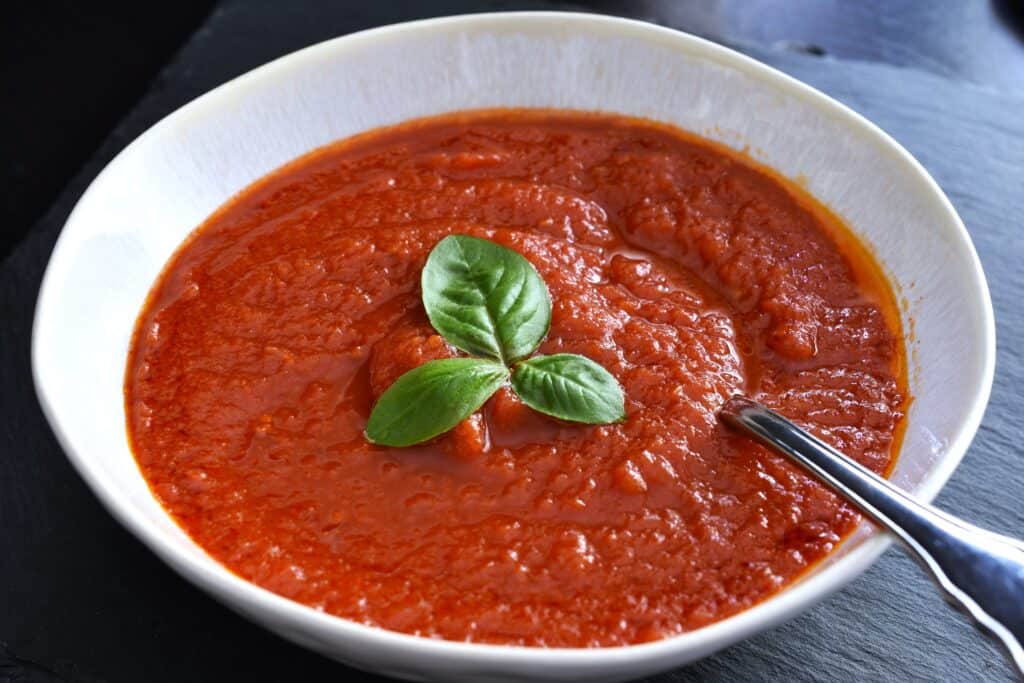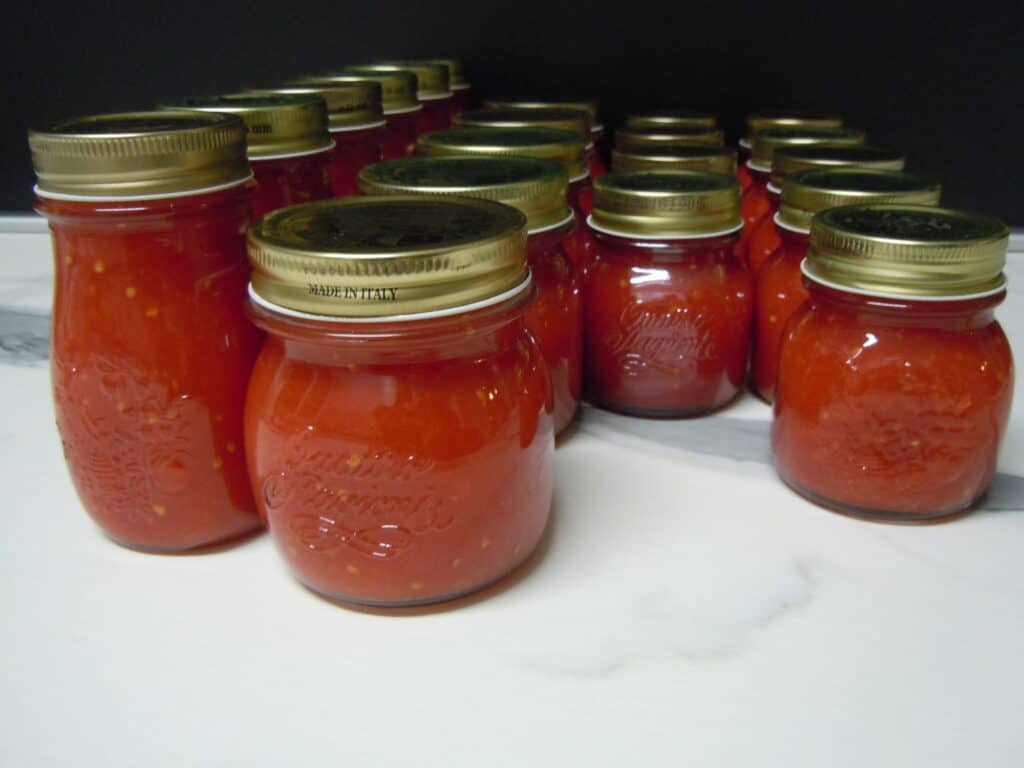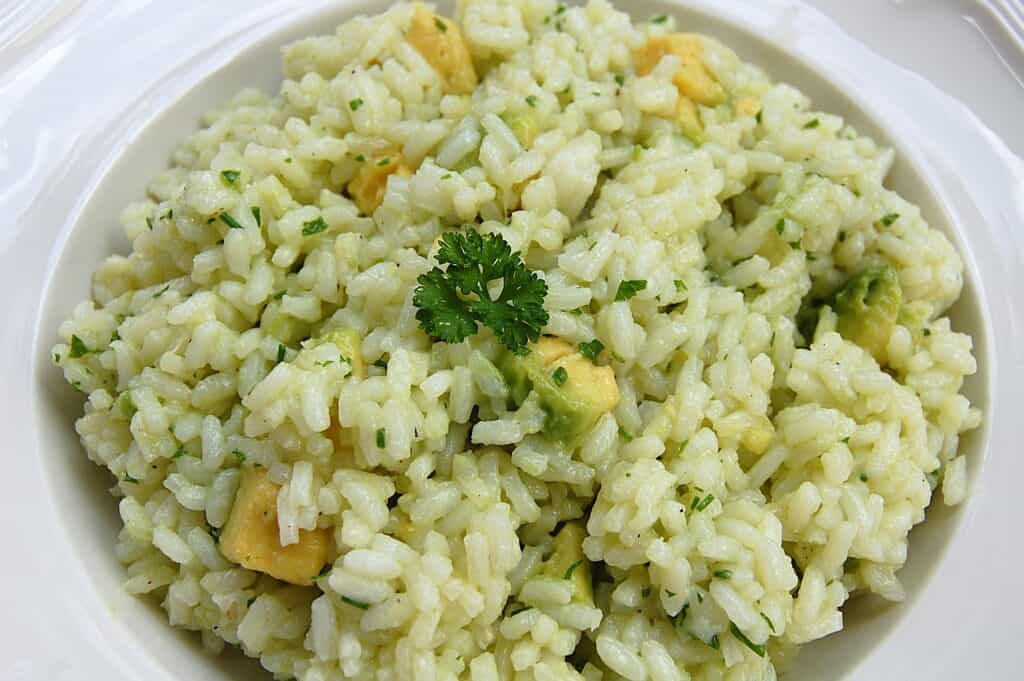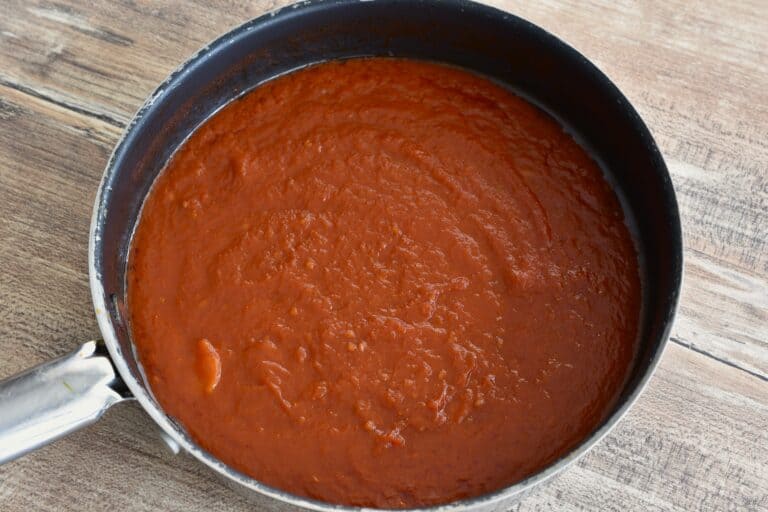Fresh tomato sauce has to be one of the simplest yet tastiest and most satisfying of all Italian pasta sauces! Sugo al pomodoro fresco is a universally loved, timeless classic. Italian-style homemade fresh tomato sauce is probably one of the best pasta sauces you’ll ever taste. Summer tomatoes are so juicy and flavourful right now, and I’ve just started harvesting mine from my garden. Every day, I come home with a basket full of different types of juicy, ripe tomatoes. This fresh tomato pasta sauce recipe highlights them in a simple, delicious way, enhancing their natural flavour.
Pasta with fresh tomato sauce is a meal that you can have on the table in 20 minutes, yet it’s a feast of flavours straight from the heart of the Italian countryside. Perfect for a busy weeknight dinner, it’s a walkover to make, kids love it, and it’s gloriously vegan!
Fresh tomato sauce isn’t just for pasta! It’s also great with vegan meatballs, polpette di melanzane (eggplant “meat”balls), and as a base for dishes like aubergine parmigiana and pizza!


As with many of Italy’s signature dishes, simplicity is the key. The fewer ingredients there are in a recipe, the more important it is that they are top-quality ingredients. Strangely enough, it’s also true that the fewer ingredients there are, the harder it is to get it right. It’s also about the method and cooking times. If you follow my step-by-step guide in the recipe card below, you’ll discover all those little secrets that will ensure that your homemade fresh tomato sauce turns out perfect every time!

Fresh tomato sauce recipe ingredients
You’ll find the exact quantities of each ingredient in the recipe card at the bottom of this page. This recipe is perfect for making smaller quantities of sauce. For larger quantities, using 3 kg or more of tomatoes, I suggest you consult my other post on how to make and jar tomato sauce.
- Tomatoes – To make fresh homemade tomato sauce for four people, you’ll need one kilo of fresh ripe tomatoes. One kilo of tomatoes will yield approximately 500 ml of tomato sauce, which is sufficient for 4 people.
- Extra virgin olive oil – For this recipe, use good quality extra virgin olive oil. It’s amazing what a difference quality ingredients make. If you want to make the best, you have to use the best.
- Garlic (optional)
- Sea salt – I use Guérande natural unrefined sea salt, which is hand-harvested in the Guérande region of France. This unrefined sea salt hasn’t been stripped of its naturally occurring minerals like the devitalised white table salt most of us have in our kitchens. Manufacturers use chemicals to refine salt to make it “clean” and white and to increase its shelf life.



Which tomatoes are best for making fresh tomato pasta sauce?
Fresh tomato sauce is best made in the summer when tomatoes are in season, flavourful, and inexpensive. Plum tomatoes are the number one choice in Italy for making tomato sauce. Varieties like San Marzano or Roma are ideal. They contain few seeds and very little water, which means more pulp and less time to reduce the sauce. They are also cheap, readily available, and abundant during the summer months in Italy. During the glut, I freeze some whole for use during the winter. When you defrost them, they peel easily without even having to blanch them. Although you can use frozen tomatoes in this recipe, I would struggle to call it fresh tomato sauce. I chop them and use them in soups and stews.
Cherry tomatoes are also a favourite. Being more acidic, they make a slightly tarter sauce, but nevertheless very tasty. It’s more time-consuming to peel the skins off because they are so small, so they might not be a great choice for larger quantities. Some people leave the skins on.
Beefsteak and ox-heart tomatoes yield a delicious tomato sauce but take much longer to cook down due to their high water content.
You can use the tomatoes you like best for this recipe – the important thing is that they are ripe. Different types of tomatoes yield different flavoured sauces. You can even mix varieties if you want.
How to make authentic Italian pasta sauce using fresh tomatoes
Instructions
You’ll find step-by-step instructions with photos in the recipe card at the bottom of this page.
Skin and chop the tomatoes
- Wash the tomatoes and leave them whole. Remove the core and make a slit down one side with a sharp knife. With smaller varieties, it isn’t usually necessary to remove the core.
- Place the tomatoes into a saucepan of boiling water so that they are almost completely submerged. Leave them for a minute, then lift them out with a slotted spoon and plunge them into a bowl of very cold water. The abrupt change in temperature will loosen the skin. As soon as the tomatoes are cool enough to handle, peel the skins off and discard them.
- Cut the tomatoes in half if they are small or into quarters if they are large.
Simmer and reduce
- Empty the saucepan that you used before and put the pieces of tomato in it. Don’t add any water.
- Turn the heat on to medium. The tomatoes will soon start to release the water they contain. Turn the heat down low and let them simmer in their own juice. This could take anywhere between 15 minutes to an hour, depending on the quantity of sauce you are making. The tomatoes need to cook down and almost disintegrate. Some of the excess water will evaporate during this phase.
- At this stage, you can decide whether to keep your sauce chunky, mash it up a bit, or blend it with an immersion blender directly in the saucepan for a smoother, passata-style sauce. If there are a lot of seeds, you can use a sieve to filter them out. Now you have your basic tomato sauce, which you can proceed to season and reduce further in the steps below.

Season and reduce further
- Crush the clove of garlic by putting it under a flat object like the blade of a butter knife and pressing down on it with the palm of your hand. Put the extra virgin olive oil into the bottom of a pan. Tilt the pan by placing a metal object like the handle of a knife underneath it so that all the oil stays on one side of the pan. Add the piece of garlic to the oil and turn the heat on to low. Gently sauté the garlic in the oil for 5 minutes on a very low heat until it is soft and golden.
- Add the tomato sauce to the pan with the garlic and oil. Simmer on low heat until the excess water evaporates, the sauce thickens, and the oil separates and migrates towards the edges of the pan. Remove the garlic and season with a pinch of salt. Your fresh tomato sauce is now ready to use.

How to serve pasta with fresh tomato sauce
Always have your sauce ready and piping hot just before the pasta is cooked. Once the pasta is al dente or cooked to your own personal liking, strain it into a colander. Quickly shake off any excess water and transfer it immediately to the pan with the fresh tomato sauce. Using two forks, one in each hand, turn the spaghetti in the sauce until it is well coated. If you’re using a short pasta shape, a serving spoon is better than a fork for mixing the pasta and the sauce.
Always remember to reserve a little of the cooking water just in case you need it. If the pasta sauce is a bit thick, the water it was cooked in is the best way to thin it down without making the sauce watery. The gluten in the cooking water does a great job of thinning the sauce down while maintaining the smooth consistency of the sauce. The sauce should glide over the pasta and adhere to it, but it shouldn’t be sticky. Once the consistency is right, transfer the pasta to the plates and serve immediately!

Optional Additions for homemade fresh tomato pasta sauce
Remember, above all, keep it simple. Adding lots of different herbs and flavourings is not the way the Italians do it. If you want to add something else to your pasta with homemade fresh tomato sauce, here are a few suggestions:
Fresh basil
In the summer, take some fresh basil leaves, slice them thinly and sprinkle over the spaghetti with homemade tomato sauce once it’s on the plate, just before serving. Alternatively, you can add a few fresh basil leaves to the sauce, which cooks them, making for a more subtle flavour compared to raw basil.


Whole roasted cherry tomatoes
If you’re looking for a more elaborate and eye-catching pasta with homemade fresh tomato sauce, you could add some whole roasted tomatoes the way some top chefs do in restaurants in Italy. Here’s how to do it: roast some cherry tomatoes, or another small tomato variety, in the oven at 250 °C until they are soft and just starting to brown. You can either roast them whole or cut them in half. Remove them from the oven, sprinkle with a little salt and arrange them decoratively over the dish just before serving.


Black olives
Pit the black olives and add them to the pan with the tomato sauce. You can leave them whole or break them into pieces.
Chili pepper
Take a small dried chili pepper and chop it into very small pieces. Add it to the pan with the oil and garlic. You can also leave it whole and remove it just before serving if you prefer just a hint of spiciness.
Olives and capers
Proceed as per black olives above, with the addition of capers. Use salted capers where possible. Rinse them well and squeeze them dry. Capers in brine will do if you can find salted ones. Add the olives and capers to the pan with the tomato sauce.
How to store fresh tomato sauce
Keep any leftover sauce in an airtight container in the fridge, where it will keep for 2 – 3 days.
Can you freeze fresh tomato sauce?
Yes, you can also freeze it. Allow the sauce to cool down completely, and then place it in an airtight container in the freezer. It will keep for up to 3 months at -18 °C. You might want to freeze it in portions for convenience.
Canning
If you have lots of tomatoes and want to make larger batches of sauce, canning them using the boiling hot water bath method is another option. This method has the advantage of not taking up space in your fridge or freezer and it will keep for at least a year. Plus, when you want to use it, you don’t even need to defrost it – you just unscrew the cap!
I make big batches of tomato sauce in August when tomatoes are cheap and abundant so that I have a stash to last me through the winter months. See more about that in my post on how to make and jar tomato sauce the Italian way.
How to reheat fresh tomato pasta sauce
Put the sauce in a pan with a lid and heat it up slowly on very low heat. If necessary, add a tablespoon of water of water as reheating may cause a bit of moisture loss even with a lid on the pan.
To reheat from frozen, first allow the sauce to defrost completely and then reheat it as above. You probably won’t need to add any water because the ice crystals create water when they melt.


I hope you enjoy this recipe for fresh tomato pasta sauce! If you like it, I’d love to hear about it! Let me know in the comments below, or take a quick pic and share it on social media. Don’t forget to tag me on Instagram or Facebook @vegan_hot_stuff – I love seeing your re-creations!
Frequently asked questions
Is fresh tomato sauce the same as marinara sauce?
It depends on where you come from. In Italy, salsa alla marinara is a tomato sauce (not necessarily made with fresh tomatoes) with finely chopped garlic, oregano and parsley. Some recipes use basil instead of oregano. In the US, marinara sauce and tomato sauce are synonymous. In Italy, tomato sauce is called sugo al pomodoro.
Do you have to peel the tomatoes for this fresh tomato pasta sauce recipe?
No, not necessarily. If you don’t mind pieces of skin in your sauce, you can skip the blanching and leave the skin on. If you don’t want bits of skin but don’t want to blanch the tomatoes either, try blending the tomatoes whole. This will reduce the skins to tiny, almost undetectable pieces.
How long should you let fresh tomato sauce simmer?
Now, this is a good question and the object of some debate. Fresh tomato sauce should have the bright, fruity aroma of fresh tomatoes. On the other hand, it should also have a sauce-like consistency with deeper, sweeter flavours. The trick is to strike a balance. If we cook a tomato sauce for hours (nothing wrong with that), we might as well just use tinned tomatoes (there’s nothing wrong with that either). But… as this is a fresh tomato pasta sauce recipe, the simmering time should be no longer than it takes to get rid of the excess water and achieve a compromise between a sweet, well-reduced sauce and a barely cooked sauce that retains the vibrant fruity flavour of fresh tomatoes.
How much fresh tomato sauce per person?
When deciding how much tomato sauce per person, here are a few factors to take into account:
- How much sauce you need depends on how much pasta you are making. As a general rule, Italians allow between 80 and 100 g of pasta per person. For every 100 g of pasta, you should calculate around 100 to 125 g of tomato sauce.
- Personal taste is the most important factor. Some people like a lot of sauce, others like less.
- You may need to reduce the sauce. If you start off with a thin tomato sauce and you want to reduce it to achieve a denser consistency, you’ll need more to start off with. Start with 125 g to obtain approximately 100 g when reduced.
What SHAPE PASTA GOES BEST WITH FRESH TOMATO SAUCE?
Every pasta shape was created with a certain type of sauce in mind. Spaghetti or any medium-sized or large pasta shape is perfect for this fresh tomato pasta sauce. Tortiglioni, elicoidali, penne lisce, penne rigate and fusili, to mention just a few, are all excellent choices for tomato sauce. Wholemeal pasta is healthier than white, but at the end of the day, it comes down to personal preference!
I hope you enjoy this recipe for Italian fresh tomato pasta sauce and that you found this post useful! If you do, it would be great if you could give it a star rating and leave a comment below! It helps other readers find my content and posts and ultimately makes my blog more successful! Thanks so much for your support! Deborah xx
While you’re here on Vegan Hot Stuff, maybe you’d also like to take a look at some other popular recipes.




Would you like to receive my recipes as soon as I publish them? Subscribe below!








